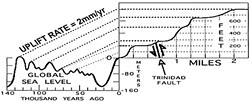[
{
"name": "Top Stories Video Pair",
"insertPoint": "7",
"component": "17087298",
"parentWrapperClass": "fdn-ads-inline-content-block",
"requiredCountToDisplay": "1"
}
]
An example of a marine terrace is the surface on which McKinleyville is built. At some time in the past, roughly 85,000 years ago, this terrace was barely below sea level, and that is why it is flat. Land above sea level was eroded down by rain and surf, while submerged land was built up by sedimentation. The airport is on the same terrace but at a higher elevation because it was further uplifted by one of our numerous faults. Prof. Gary Carver has mapped terraces along our coast to unravel its history of faulting.
Look closely at the slopes east of Trinidad and you will discern a sequence of terraces cut into the mountain by wave action, a very potent process. The higher terraces are older, but all are difficult to date because fossils are rare. Prof. Bud Burke has used the degree of soil development to provide estimates of terrace ages.
The sequence of terraces is a consequence of a dance between fault-related progressive uplift and fluctuating sea level. Continental glaciation lowered sea level 140 meters 20,000 years ago. A global "sea level curve" has been deciphered from dated coral reefs stranded on steadily rising tropical islands [J. Darter, Compilation of a sea level curve: Geology Proceedings (2000)]. The diagram shows my attempt at correlating this sea level curve with terraces northeast of Trinidad, assuming a steadily rising coast. It all fits together if this particular region rose at an average rate of 2 millimeters per year.
The highest terrace at 800 feet above sea level was beveled by wave action 125,000 years ago, when the sea was close to its present level and rising with the land. Bud Burke declares that my interpretations are compatible with his soil analyses.
Appreciate your marine terraces; without them we would all be living on precarious hillslopes.
Don Garlick is a geology professor retired from HSU. He invites any questions relating to North Coast science, and if he cannot answer it he will find an expert who can. E-mail [email protected].
Speaking of Science
-

HSU Expanding Curriculum with Polytechnic Push
Jun 15, 2021 -

Davos Won't Save Us
Jan 23, 2020 -

The Need to Study Weed
Jan 16, 2020 - More »
more from the author
-
Nuclear Matters
- May 6, 2010
-
Sophie Smells a Shaker
- Feb 4, 2010
-
The Roots of Love
- Feb 5, 2009
- More »
































